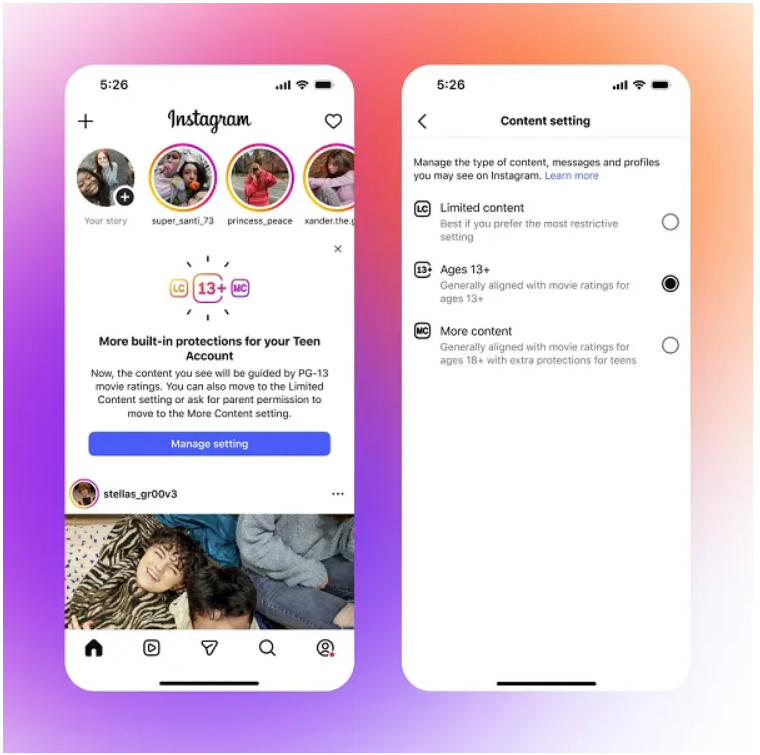Instagram is rolling out a major update to how teen accounts are treated. With the new rules, all users under 18 will be automatically put into a PG-13 mode by default, meaning they’ll see only content that aligns with movie-style “13+” guidelines. Teens won’t be able to opt out without parental permission.
This marks one of Instagram’s most significant safety shifts since introducing teen accounts — and it could reshape how content is discovered, consumed, and created for younger audiences.
What the New Restrictions Entail ?

Here’s a breakdown of the changes teen users will experience:
- Automatic PG-13 Mode for Teens
Teen accounts (under 18) will now be placed in a default “13+” setting. They’ll see content similar in tone to what’s acceptable in PG-13 films — exposure to strong language, risky stunts, content about drug paraphernalia, and other mature themes will be heavily filtered or hidden. - No Opt-Out Without Parental Permission
Unlike prior teen protections, where a user might adjust some settings, this new setup cannot be changed by the teen alone — they’ll need parental approval to loosen content restrictions. - Following & Interactions Curbed
Teens will no longer be able to follow accounts that regularly post age-inappropriate content, or those whose bio or name suggests adult themes. Even if a teen already follows such an account, they will lose access — they won’t see or interact with that content, comments, or messages.Adult or non-teen accounts with such content also won’t be able to follow, comment under, or DM teen accounts. - Search Limitations Expanded
Instagram will block a wider array of search terms from teen users, not just obvious ones. Terms like “alcohol” or “gore” (even misspelled) will be suppressed. - Restricted Content Across the App
The limitations extend beyond Explore and Reels — Instagram says these restricted content rules will also apply to Feed, Stories, comments, and suggested content even from accounts a teen follows. - AI & Response Controls
Instagram’s AI features (chatbots or suggestions) will also be governed by PG-13 constraints. It means AI should not deliver age-inappropriate responses to teen users under this new mode. - Parental Controls / “Limited Content” Setting
For guardians who want stricter enforcement, Instagram introduces a “Limited Content” setting. That further locks down content visibility, limiting interactions and hiding comments.
Instagram says these changes are grounded in feedback from parents and are intended to make protections more understandable — after all, many people intuitively grasp what PG-13 means because of movies.
The rollout begins immediately in markets like the U.S., U.K., Australia, and Canada, with plans for global expansion.
Why Instagram Is Doing This ?
There are a few driving motivations behind these tougher rules:
- Regulatory & Legal Pressure
Governments globally are increasingly scrutinizing social media’s impact on youth. By strengthening protections, Instagram is trying to preempt stricter regulations or potential fines. - Addressing Criticism / Reputation Risk
Instagram and Meta have faced backlash over claims that the platform exposes minors to harmful or manipulative content — these changes are part of a response to those critiques. - Improving Parental Trust
By anchoring restrictions in a known standard like PG-13, Instagram hopes parents will better understand what protections mean. - Aligning Teen & Adult Content Management
The move ensures a clearer boundary between content for mature audiences and content safe for teens — reducing ambiguity in algorithmic decisions about what to show.
Potential Impact & Drawbacks
While the intent seems solid, the changes carry trade-offs and risks:
- Reduced Reach for Some Creators
If your content leans toward edgier themes, teens who would otherwise see you might be filtered out entirely. That could reduce exposure in a key demographic. - Over-filtering or False Negatives
Algorithms are imperfect. Some content might be overly restricted, including creative or expressive posts that aren’t problematic. Teen users may feel censored or limited. - Teen Backlash or Migration
Teens who feel constrained might shift to other platforms less restricted or use bypass methods. - Parental Consent Bottlenecks
Because opt-out requires guardian approval, some teens might stay locked in stricter mode even if they want more varied content. - Fragmentation of Discovery
The content ecosystem may split: creators must cater separately to teen-filtered feeds and adult feeds, complicating strategy.
What Creators & Brands Should Do ?
To adapt to this update and preserve reach and engagement, consider the following strategies:
- Lean into Teen-Friendly Themes
Prioritize topics and styles that align closely with PG-13 sensibilities: lifestyle, hobbies, education, light entertainment. Avoid overly provocative or mature themes if teen reach matters to you. - Test Across Audience Profiles
If you manage multiple audience segments, use different content strategies for teens vs general users. This is where having multiple profiles helps. For example, you could use Bulk Instagram Accounts to test content types safely across teen and adult audiences. - Use Safe Hooks / Universal Messaging
Create headlines or intros that appeal broadly and avoid triggering filters. Use visual storytelling, tone, and emotional resonance rather than shock or provocative imagery. - Optimize for Other Demographics Too
Diversify your audience base so that teen filtering doesn’t disproportionately affect your performance. Strengthen your adult audience engagement too. - Monitor Analytics Closely
Pay attention to reach drops among younger segments. Segment insights by age if possible, and track whether content is being filtered more often. - Encourage Parental Engagement
If parents are required for opt-out, content that subtly becomes acceptable with parental trust may help. Posts about family, education, or safety can build goodwill.
